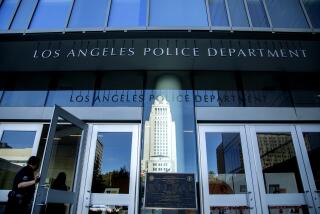Who’ll stop the gangs?
- Share via
Gang violence is to Los Angeles politics as the weather is to conversation: Everybody talks about it, and nobody ever does anything about it.
Policing occasionally provides a temporary surcease, as it did last week when a drive-by murder next to a grammar school playground and a subsequent shootout between heavily armed gunmen and Los Angeles Police Department officers paralyzed parts of two neighborhoods northeast of downtown for hours. Early Wednesday morning, a police sweep apprehended 19 alleged gang members and seized guns and drugs.
But though the department is willing to take on gang violence where it becomes particularly virulent, treating this solely as a policing issue is a bit like asking the overextended, understaffed LAPD to engage in an endless game of Whac-a-Mole. There were 200 officers involved in Wednesday’s predawn sweep -- and anyone who knows just how few cops are on the city’s streets at any given moment also knows what that kind of diversion of force means.
The problem’s sheer scope makes it clear that it won’t yield to a solution based entirely -- or even mainly -- on law enforcement. People who believe most of the statistics thrown around during debates over gangs usually are the sort who respond to e-mails from Nigeria with their banking information. Still, conservative analysts estimate that as many as 40,000 people belong to the 700 or so gangs in the city of L.A. Countywide, there may be as many as 1,200 gangs with 80,000 members. The material cost of their criminality may be as much as $2 billion a year; the human toll in lives lost or deformed defies calculation.
Every few years, our political establishment runs out of ways to look away and begins demanding another study, a fresh approach, a new initiative. First came an assessment of Los Angeles’ anti-gang efforts commissioned by the City Council and written last year by civil rights attorney Connie Rice.
She’s one of those civic activists who is both principled and shrewd, but the report is a dead letter. It’s more than 100 pages long and demands new programs by the carload. Essentially, it advocates what it calls a citywide Marshall Plan with a price tag of more than $1 billion. (At one point, the report estimates that the programs required to get the gangs off one South Los Angeles high school campus, Manual Arts, would cost more than $50 million.)
Even if the city and state were not in the grip of a budget crisis, there is no chance that sums of that size ever will be available to assist a group of people who probably are less popular than the Taliban among L.A. voters.
Meanwhile, City Controller Laura Chick this month issued her own audit of ongoing anti-gang efforts. She doesn’t see a need for any new funds, but she wants to reallocate money from some programs and consolidate all of them under a single anti-gang czar, who would report directly to Mayor Antonio Villaraigosa. He likes the idea, as do Gov. Arnold Schwarzenegger and Police Chief William J. Bratton.
Chick’s proposal, however, is unlikely to go any further than Rice’s because it’s opposed by Councilman Tony Cardenas, who chairs the Ad Hoc Committee on Gang Violence and Youth Development. “They’re recommending that the intervention and prevention programs basically be put in the mayor’s office,” he said, “which is a policy matter first and foremost that should, and will, be vetted through the council.” In other words, economic and political stalemate as usual -- and another chance to avert our collective gaze.
Meanwhile, consider these facts -- as reported by Times staff writer Sam Quinones -- concerning Marcos Salas, the 36-year-old man whose killing touched off last week’s lockdown of much of northeast Los Angeles. He was one of eight sons brought to Los Angeles from Arizona as children by his impoverished farmworker parents. Marcos dropped out of high school, joined the Cypress Park gang and went to prison twice -- once on a drug charge, once for attempted murder while on parole.
Since getting out, he’d reportedly tried to stay out of gang activities, spending time with his partner, their six daughters and two granddaughters. Salas, like many ex-cons, was unemployed, supported by his partner’s welfare check. He had his 2-year-old granddaughter by the hand when he was shot dead outside the grammar school where he’d gone to walk one of his daughters home.
For Marcos Salas, gang membership was simply the apex on a pyramid of social pathologies that made up his troubling and -- for others -- troublesome life.
We no longer can afford to either sentimentalize or demonize the thousands among us caught up in choices and circumstances like those with which Salas lived. Most of all, we cannot go on looking away.
More to Read
Sign up for Essential California
The most important California stories and recommendations in your inbox every morning.
You may occasionally receive promotional content from the Los Angeles Times.










